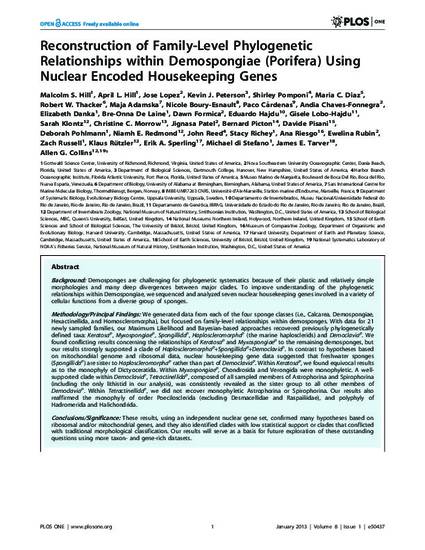
- Amino acid analysis,
- Animal phylogenetics,
- Bayes theorem,
- Mitochondria,
- Paleogenetics,
- Phylogeography,
- Sponges,
- Topology
Background: Demosponges are challenging for phylogenetic systematics because of their plastic and relatively simple morphologies and many deep divergences between major clades. To improve understanding of the phylogenetic relationships within Demospongiae, we sequenced and analyzed seven nuclear housekeeping genes involved in a variety of cellular functions from a diverse group of sponges.
Methodology/Principal Findings: We generated data from each of the four sponge classes (i.e., Calcarea, Demospongiae, Hexactinellida, and Homoscleromorpha), but focused on family-level relationships within demosponges. With data for 21 newly sampled families, our Maximum Likelihood and Bayesian-based approaches recovered previously phylogenetically defined taxa: Keratosap, Myxospongiaep, Spongillidap, Haploscleromorphap (the marine haplosclerids) and Democlaviap. We found conflicting results concerning the relationships of Keratosap and Myxospongiaep to the remaining demosponges, but our results strongly supported a clade of Haploscleromorphap+Spongillidap+Democlaviap. In contrast to hypotheses based on mitochondrial genome and ribosomal data, nuclear housekeeping gene data suggested that freshwater sponges (Spongillidap) are sister to Haploscleromorphap rather than part of Democlaviap. Within Keratosap, we found equivocal results as to the monophyly of Dictyoceratida. Within Myxospongiaep, Chondrosida and Verongida were monophyletic. A well supported clade within Democlaviap, Tetractinellidap, composed of all sampled members of Astrophorina and Spirophorina (including the only lithistid in our analysis), was consistently revealed as the sister group to all other members of Democlaviap. Within Tetractinellidap, we did not recover monophyletic Astrophorina or Spirophorina. Our results also reaffirmed the monophyly of order Poecilosclerida (excluding Desmacellidae and Raspailiidae), and polyphyly of Hadromerida and Halichondrida.
Conclusions/Significance: These results, using an independent nuclear gene set, confirmed many hypotheses based on ribosomal and/or mitochondrial genes, and they also identified clades with low statistical support or clades that conflicted with traditional morphological classification. Our results will serve as a basis for future exploration of these outstanding questions using more taxon- and gene-rich datasets.
